Unit6 At the farm A let’s learn评课稿
- 格式:doc
- 大小:24.50 KB
- 文档页数:2
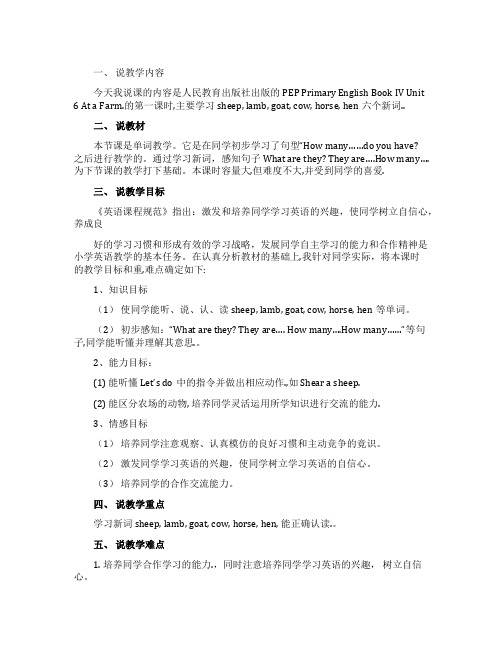
一、说教学内容今天我说课的内容是人民教育出版社出版的PEP Primary English Book IV Unit6 At a Farm.的第一课时,主要学习sheep, lamb, goat, cow, horse, hen六个新词..二、说教材本节课是单词教学。
它是在同学初步学习了句型“How many……do you have?之后进行教学的。
通过学习新词,感知句子What are they? They are….How many….为下节课的教学打下基础。
本课时容量大,但难度不大,并受到同学的喜爱.三、说教学目标《英语课程规范》指出:激发和培养同学学习英语的兴趣,使同学树立自信心,养成良好的学习习惯和形成有效的学习战略,发展同学自主学习的能力和合作精神是小学英语教学的基本任务。
在认真分析教材的基础上,我针对同学实际,将本课时的教学目标和重,难点确定如下:1、知识目标(1)使同学能听、说、认、读sheep, lamb, goat, cow, horse, hen等单词。
(2)初步感知:“What are they? They are…. How many….How many……”等句子,同学能听懂并理解其意思.。
2、能力目标:(1) 能听懂Let’s do中的指令并做出相应动作.,如Shear a sheep.(2) 能区分农场的动物, 培养同学灵活运用所学知识进行交流的能力.3、情感目标(1)培养同学注意观察、认真模仿的良好习惯和主动竞争的竟识。
(2)激发同学学习英语的兴趣,使同学树立学习英语的自信心。
(3)培养同学的合作交流能力。
四、说教学重点学习新词sheep, lamb, goat, cow, horse, hen, 能正确认读.。
五、说教学难点1. 培养同学合作学习的能力.,同时注意培养同学学习英语的兴趣,树立自信心。
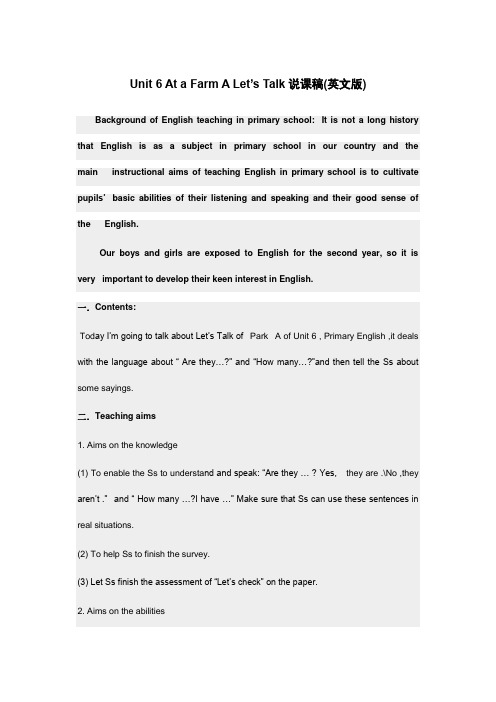
Unit 6 At a Farm A Let’s Talk说课稿(英文版) Background of English teaching in primary school: It is not a long history that English is as a subject in primary school in our country and the main instructional aims of teaching English in primary school is to cultivate pupils’basic abilities of their listening and speaking and their good sense of the English.Our boys and girls are exposed to English for the second year, so it is very important to develop their keen interest in English.一.Contents:Tod ay I’m going to talk about Let’s Talk of Park A of Unit 6 , Primary English ,it deals with the language about “ Are they…?” and “How many…?”and then tell the Ss about some sayings.二.Teaching aims1. Aims on the knowledge(1) To enable the Ss to understa nd and speak: “Are they … ? Yes,they are .\No ,they aren’t .”and “ How many …?I have …” Make sure that Ss can use these sentences in real situations.(2) To help Ss to finish the survey.(3) Let Ss finish the assessment of “Let’s check” on the paper.2. Aims on the abilities(1) To develop Ss’ abilities of listening and speaking.(2) To train the Ss’ ability of working in groups.(3) To foster Ss’ abilities of communication and their innovation.3. Aims on the emotion(1)To foster Ss’ consciousness of good co-operation and proper competition.(2) To lead Ss to show their loveliness to the animals.三.Key-points of this lesson(1) To help Ss ask and answer the question: Are they…? How many…?”(2) To enable Ss to study in groups and co-operate skillfully.(3) To develop Ss’ interest in English.四.Difficult points(1) To help the Ss ask and answer the question “Are they…?” “How many… ?” and make sure they can use the plural nouns correctly.(2) To finish the survey by themselves and the Exes on the paper .五.Teaching methodsAs we all know: the main instructional aims of learning English in primary school is to cultivate pupils’ basic abilities of listening and speaking and their good sense of the English language. So in this lesson I’ll mainly use “Task- based” teaching method. That is to say,I will let the Ss learn in real situations, finish a task by making a survey to help the Ss to get a better understanding of the key structure of the dialogue. I will arrange four kinds of activities : singing, guessing game, finishing a survey and having acompetition. And in this lesson a recorder, CAI, school things and a printed form will be needed. Students should prepare some school things.六.Teaching procedures and purposes of my designing.I’ll finish this lesson in four steps.Step One Warm up.1. Some greetings with the students.eg , Nice to meet you !I like cats , do you like cats?…2.Song : Old Macdonald Had a farmStep Two Presentation.1.Are they…?a. The T show the picture of a farmer and say, “Look , he is a farmer , he has a farm . Let’s go to his farm and have a look , OK?” And show the word of farm.b. Read the word farm.c. The T show a picture o f a sheep and say, “ Is it a sheep ?”Ss : Yes , it is .( If the students can’t answer , the T give two choice and then show the whole answer . )d. The T show a picture of some sheep and say, “Are they sheep ?”And give the students a way to have a try to answer the question.e. The Ss read after the T about the two groups of sentences .f. The T show a picture of a goat and ask, “Is it a sheep?”------No, it isn’t.T: What is it ?Ss: It’s a goat.g. A picture of sheep and ask, “ Are they sheep ?”------ No, they aren’t..T: What are they ?Ss: They are goats.h. The Ss read after the T about the two groups of sentences.i. Another groups :(1)----Is it a horse ? ---- Yes, it is.(2)----Are they horses? ----- Yes, they are.j. The T show a picture of a donkey and ask, “Is it a horse?”------ No, it isn’t.T: What is it ?If the Ss can’t speak , the T tells them, “ This is a donkey.” And have a practice about this word.k.Show a picture of donkeys to show donkeys.T: Are they horses ?Ss: No, they aren’t.T: What are they?Ss: They are donkeys.l. Several pictures:(1)-----Is it a hen? -------Yes, it is. -----Is it fat? ---------Yes, it is.(2)-----Are they hens? ------Yes, they are. -------Are they fat? -----Yes, they are.(3)-----Is it a cow? -------Yes, it is . -----Is it big? ------Yes, it is .(4)-----Are they cows? -------Yes, they are.m. Game and practice.The Ss make sentences according to the voice with the structure :Are they…?Yes, they are. \No, they aren’t.2. How many…?a. After the above practices let the Ss listen to a song : Body Song and have a rest.b. Then answer the questions:How many eyes\ ears \ mouths \ noses \ hands \ legs do you have ?c. Make a survey with the structure:A: How many… do you have ?B: I have …d. Now , let’s count about our classroom:How many doors \ windows \ students \ desks \ teachers \ computers do we have ?e. The T show the photo of a family and have a practice about :How may…do they have ?They have ….3. Let’s talka. T: Today , Mike and Sarah also go to a farm , let’s listen to the tape twice and say T orF .(1). This farm is so big.(2). There are sheep at the farm.(3). There are horses at the farm.(4). The hens are fat.(5). The farmer has one hundred cows.b. Read and show.(1). The Ss read after the tape .(2). Let several students act it out.Step Three Consolidation and Extensiona.Fill in the blanks according to the pictures on the paper.b.Some sayings:(1). A running horse no spur.(2). A cat has nine lives.(3). Never often to teacher fish to swim.(3). Love me , love my dog .(4). Separate the sheep from the goats.Step Four Homeworka.Make a new dialogue according to the test .b.Preview the next part .七.Evaluation:1. The Ss are very active and they have good English level .2.The progress is too long the first part is practiced a lot so the last little part is not finished ,but the Ss all use them freely and correctly. And the developing part is a little rusher .I think the T should say something about it quickly but not give up.3.The T write the words on the blackboard and let the Ss find out the rules about the PL of the nouns. Let the Ss can learn rules without teaching grammars.Generally speaking , we must pay attention to the little aspects of the whole class. So the T also must pay full attention to them when we get ready for the whole class.。
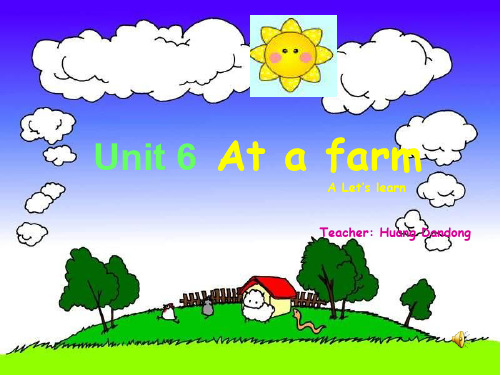

PEP英语四年级下册Unit 4 At the farm
B Let’s learn评课意见
王老师:陈老师教态自然大方,教学过程流畅,她采用各种方式讲授本课,尤其用哼歌引入绵羊这个单词,处理的很好。
建议:1.在学习奶牛时,陈老师可以调整下顺序,先出示音标台历,利用学过的单词now、how、引出cow并进行扩展,2.练习环节,Let’s be a guide,既然是导游,注意形式,可以准备旅游帽等物品,而不是问答形式。
林老师:陈老师教具、板书制作精美、有特色,建议:1.在学习hen时图片已出示就不用问学生单词的意思,2.猜单词cow时,仅出示大问号有点无从下手,可以给些提示,3.德育那里,本节课是家禽类动物而非野生动物,播放野生动物视频不合适。
陈老师;音标教学解读到位,学生自然拼读能力很好,建议:1.复习音标歌谣时。
可以标出连读符号,2.大家讨论hens的发音,3. 猜cow时,最后一句课件显示What am I?而非Who,这无伤大雅,因为本身不是猜人。
另外环节设计可以,但在出示时可以一句一句呈现,激发兴趣。
4.sheep,学生对其复数不理解可直接出示汉语告知。
5.陈主任给大家科普解释大单元教学并提出要求。
田老师:给学生科普cow和 cattle、 sheep和 goat的区别,扩展八骏图传统文化。
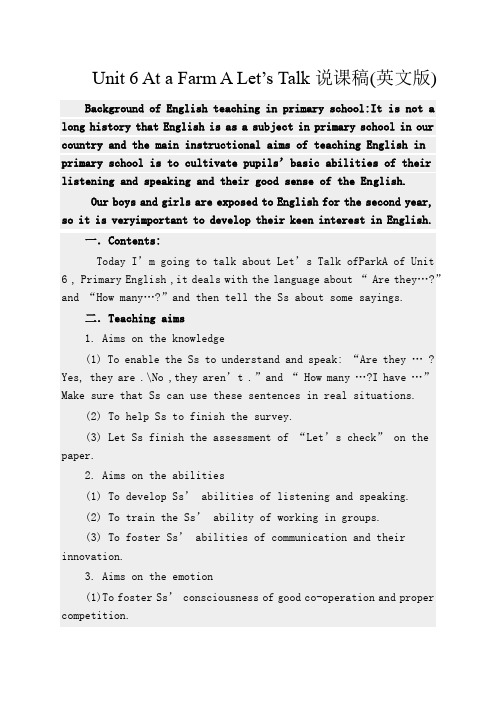
Unit 6 At a Farm A Let’s Talk说课稿(英文版)Background of English teaching in primary school:It is not a long history that English is as a subject in primary school in our country and the main instructional aims of teaching English in primary school is to cultivate pupils’basic abilities of their listening and speaking and their good sense of the English.Our boys and girls are exposed to English for the second year, so it is veryimportant to develop their keen interest in English.一.Contents:Today I’m going to talk about Let’s Talk ofParkA of Unit 6 , Primary English ,it deals with the language a bout “ Are they…?” and “How many…?”and then tell the Ss about some sayings.二.Teaching aims1. Aims on the knowledge(1) To enable the Ss to understand and speak: “Are they … ? Yes, they are .\No ,they aren’t .”and “ How many …?I have …” Make sure that Ss can use these sentences in real situations.(2) To help Ss to finish the survey.(3) Let Ss finish the assessment of “Let’s check” on the paper.2. Aims on the abilities(1) To develop Ss’ abilities of listening and speaking.(2) To train the Ss’ ability o f working in groups.(3) To foster Ss’ abilities of communication and their innovation.3. Aims on the emotion(1)To foster Ss’ consciousness of good co-operation and proper competition.(2) To lead Ss to show their loveliness to the animals.三. Key-points of this lesson(1) To help Ss ask and answer the question: Are they…? How many…?”(2) To enable Ss to study in groups and co-operate skillfully.(3) To develop Ss’ interest in English.四. Difficult points(1) To help the Ss ask and answer the question “Are they…?” “How many… ?” and make sure they can use the plural nouns correctly.(2) To finish the survey by themselves and the Exes on the paper .五. Teaching methodsAs we all know: the main instructional aims of learning English in primary school is to cu ltivate pupils’ basic abilities of listening and speaking and their good sense of the English language. So in this lesson I’ll mainly use “Task-based” teaching method. That is to say,I will let the Ss learn in real situations, finish a task by making a survey to help the Ss to get a better understanding of the key structure of the dialogue. I will arrange four kinds of activities : singing, guessing game, finishing a survey and having a competition. And in this lesson a recorder, CAI, school things and a printed form will be needed. Students should prepare some school things.六. Teaching procedures and purposes of my designing.I’ll finish this lesson in four steps.Step One Warm up.1. Some greetings with the students.eg , Nice to meet you !I like cats , do you like cats?…2.Song : Old Macdonald Had a farmStep Two Presentation.1.Are they…?a. The T show the picture of a farmer and say, “Look , he is a farmer , he has a farm . Let’s go to his farm and have a look , OK?” And show the word of farm.b. Read the word farm.c. The T show a picture of a sheep and say, “ Is it a sheep ?”Ss : Yes , it is .( If the students can’t answer , the T give two choice and then show the whole answer . )d. The T show a picture of some sheep and say, “Are they sheep ?”And give the students a way to have a try to answer the question.e. The Ss read after the T about the two groups of sentences .f. The T show a picture of a goat and ask, “Is it a sheep?”------No, it isn’t.T: What is it ?Ss: It’s a goat.g. A picture of sh eep and ask, “ Are they sheep ?”------ No, they aren’t..T: What are they ?Ss: They are goats.h. The Ss read after the T about the two groups of sentences.i. Another groups :(1)----Is it a horse ?---- Yes, it is.(2)----Are they horses? ----- Yes, they are.j. The T show a picture of adonkey and ask, “Is it a horse?”------ No, it isn’t.T: What is it ?If the Ss can’t speak , the T tells them, “ This is a donkey.” And have a practice about this word.k.Show a picture of donkeys to show donkeys.T: Are they horses ?Ss: No, they aren’t.T: What are they?Ss: They are donkeys.l. Several pictures:(1)-----Is it a hen? -------Yes, it is. -----Is it fat?---------Yes, it is.(2)-----Are they hens?------Yes, they are.-------Are they fat?-----Yes, they are.(3)-----Is it a cow? -------Yes, it is . -----Is it big?------Yes, it is .(4)-----Are they cows?-------Yes, they are.m. Game and practice.The Ss make sentences according to the voice with the structure : Are they…?Yes, they are. \No, they aren’t.2. How many…?a. After the above practices let the Ss listen to a song : Body Song and have a rest.b. Then answer the questions:How many eyes\ ears \ mouths \ noses \ hands \ legs do you have ?c. Make a survey with the structure:A: How many… do you have ?B: I have …d. Now , let’s count about our classroom:How many doors \ windows \ students \ desks \ teachers \ computers do we have ?e. The T show the photo of a family and have a practice about :How may…do they have ?They have ….3. Let’s talka. T: Today , Mike and Sarah also go to a farm , let’s listen to the tape twice and say T or F .(1). This farm is so big.(2). There are sheep at the farm.(3). There are horses at the farm.(4). The hens are fat.(5). The farmer has one hundred cows.b. Read and show.(1). The Ss read after the tape .(2). Let several students act it out.Step Three Consolidation and Extensiona.Fill in the blanks according to the pictures on the paper.b.Some sayings:(1). A running horse no spur.(2). A cat has nine lives.(3). Never often to teacher fish to swim.(3). Love me , love my dog .(4). Separate the sheep from the goats.Step Four Homeworka.Make a new dialogue according to the test .b.Preview the next part .七.Evaluation:1. The Ss are very active and they have good English level .2.The progress is too long the first part is practiced a lot so the last little part is not finished ,but the Ss all use them freely and correctly. And the developing part is a little rusher .I think the T should say something about it quickly but not give up.3.The T write the words on the blackboard and let the Ss find out the rules about the PL of the nouns. Let the Ss can learn rules without teaching grammars.Generally speaking , we must pay attention to the little aspects of the whole class. So the T also must pay full attention to them when we get ready for the whole class.。
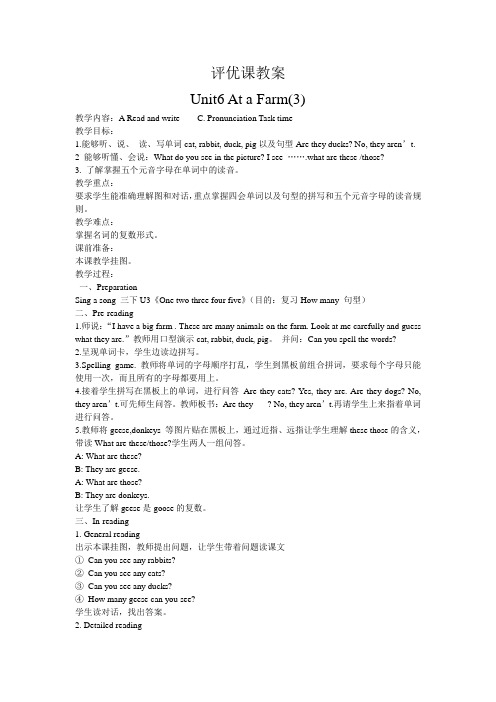
评优课教案 Unit6 At a Farm(3) 教学内容:A Read and write C. Pronunciation Task time 教学目标: 1.能够听、说、 读、写单词cat, rabbit, duck, pig以及句型Are they ducks? No, they aren’t. 2 能够听懂、会说:What do you see in the picture? I see …….what are these /those? 3. 了解掌握五个元音字母在单词中的读音。 教学重点: 要求学生能准确理解图和对话,重点掌握四会单词以及句型的拼写和五个元音字母的读音规则。 教学难点: 掌握名词的复数形式。 课前准备: 本课教学挂图。 教学过程: 一、Preparation Sing a song 三下U3《One two three four five》(目的:复习How many 句型) 二、Pre-reading 1.师说:“I have a big farm . These are many animals on the farm. Look at me carefully and guess what they are.”教师用口型演示cat, rabbit, duck, pig。 并问:Can you spell the words? 2.呈现单词卡,学生边读边拼写。 3.Spelling game. 教师将单词的字母顺序打乱,学生到黑板前组合拼词,要求每个字母只能使用一次,而且所有的字母都要用上。 4.接着学生拼写在黑板上的单词,进行问答 Are they cats? Yes, they are. Are they dogs? No, they aren’t.可先师生问答。教师板书:Are they-----? No, they aren’t.再请学生上来指着单词进行问答。 5.教师将geese,donkeys 等图片贴在黑板上,通过近指、远指让学生理解these those的含义,带读What are these/those?学生两人一组问答。 A: What are these? B: They are geese. A: What are those? B: They are donkeys. 让学生了解geese是goose的复数。 三、In-reading 1. General reading 出示本课挂图,教师提出问题,让学生带着问题读课文 ① Can you see any rabbits? ② Can you see any cats? ③ Can you see any ducks? ④ How many geese can you see? 学生读对话,找出答案。 2. Detailed reading 教师先提出问题: (1) What do you see in the picture? (2)What are those? Are they ducks? (3)What are these? Are they dogs? 让学生再读对话,找出问题的答案,进一步理解对话。 3.Read and write ①接上一节,师板书,边讲解边书写。 ②阅读课文后和声课本做下面的练习题。 根据单词的首字母填空。 ——What do you see in the picture ? ——I see five c___s, eight r____s and two p___s. ——What are those ? Are they dogs? ——No, they aren’t. Are they d___gs? ——Yes, they are. 3、 Listen to the tape. 4、 Read aloud. 四、Post-reading 1. 分角色朗读对话。 2. 给出学生五分钟的时间写出自己家里有的家禽及各种小动物,然后和同学一起分享。 五、Progress A.检测题 1、连词成句 ⑴ a , ducks, are , they ? ⑵ are, they, not, no ? 2.找朋友 老师准备好名词复数的卡片,在黑板上写好单数形式,让学生将复数形式卡片贴在黑板上。 B.总结课堂,评价学生表现 总结本课所学知识,表扬课上表现好的同学。 C.Homework 看看家里的蔬菜有哪些是我们本课所学的,把它们说给爸爸妈妈听。
第一课时:Let’s learn Let’s do第六单元的教学内容都是围绕“farm”这个主题展开的。
主要包括有关农场上的动物、农作物名词及其复数形式的表达方式,以及语言结构:What are they?Are they…What are these/those?Are these/those…?How many…are there?的学习和应用。
教学目标:知识技能目标:1. 能够听、说、记读本课时的主要单词:hen, sheep, cow , horse, goat , lamb2. 听懂指示语,并按要求做出相应的动作,如:Milk a cow情感文化目标:1.能以得体的方式与人交际:询问名称和数量。
2.动物是我们的好朋友,我们要爱护动物主动询问、合作、沟通教学重、难点:本课时需要重点掌握农场上常见的牲畜的名称。
难点是“horse”与”house”的发音区别:“how many”与“how much”含义的差别以及“lamb”的发音。
课前准备:CAI。
教师准备录音机及录音带。
学生准备1—6张词卡。
如果条件允许,学生可以带相关的玩具。
教学步骤:热身(Warm-up)日常口语练习:What’s the weather like today? Is it warm?Oh, what a lovely day? Let’s go to the farm![设计意图]:教师由天气自然转入本单元话题。
预习:(Preview)学生听Let’s do的录音,教师根据录音做出相应的动作;学生再听录音,同时模仿教师的动作。
教师在黑板上画些农场动物的简笔画,操练句子“Are they……?”[设计意图] 预习环节的设计,为课中做游戏做准备,也为第二课时句子习打基础。
新课呈现(Presentation)Let’s learn(1) 教师出示农场动物单词卡片,对学生说:Look at these animals: where do they live? They live on the farm. 让学生整体感知所学内容。
PEP Book4 Unit6 At a FarmSection A Let`s talk 教案(简案)曹卓课题:Unit 6 A Let`s talk教学目标:1.能力目标:能听懂并运用句型Are they …? How many… ?2.知识目标:听、说、认读Let`s talk 中的单词和句子,理解Let`stalk的内容。
3.态度情感、策略:善待动物;保护环境.4.学习策略:主动询问、合作、沟通。
教学重点:句型: Are they …? How many… ?教学难点:名词复数及其读音.教具准备:1. 教学课件。
2. 教学录音带。
3. 单词图卡4. 课文插图。
5. 小组比赛道具。
6. 学生自己准备的小图卡。
教学过程:Warm-up and Revision1. 复习动物单词及其复数形式、句型:What are they? They are…2. Let`s do (p 70)Presentation1.Sentence pattern: Are they ….s? Yes, they are./ No, they aren`t.Word: donkey(1) CAI 渐现lions 图片, 引导学生用Are they …s? 猜测图片中的动物, 呈现新句型.(2) 利用donkeys 的声音文件和刚学习的新句型引授生词“donkey”.(3) 操练句型。
Pair work ( win cards ): 教师先同一名学生做示范, 然后让学生两人一组利用准备好的图卡练习新学的句型, 看两分钟内谁赢得的图片多.2. Sentenc pattern: How many ….s do you have?(1) 承上, 教师问: Who has the most cards? xxx, how many cards do you have? 引出句型How many ….s do you have?(2) 操练句型。
四年级下英语Unit4第5课《At the farm》教案Part B Read and write & Let’s check & Let’s sing 教学内容与目标能够通过图片等读懂短文。
教学难点能够通过观察图片理解例句,并能够在有意义的语境中仿写核心句。
教学准备PPT课件、课文录音、视频、教学卡片等。
教学过程Step 1: Pre-reading1. Greetings.2. Enjoy the song—Mary has a little lamb. (出示课件)3. Revision and Lead-in.①T: Mr MacDonald has a farm. At his farm he has a lot of vegetables and animals. Let’s have a look. (课件出示:本单元的主情景图) T: What are these/those?Ss: They’re…T: Are they…?Ss: Yes, they are. / No, they aren’t.T: Mike makes an introduction of the farm. Let’s have a look! Step 2: While-reading②1. Look at the pictures and read the sentences of Picture 1 and Picture2.T: This is Mr MacDonald’s farm. What kinds of vegetables does he have? Let’s go to his vegetable garden and have a look.(课件出示:教材P43 Read and tick第一、二幅图)Students read and tick by themselves.Play the recording. (出示课件)Students listen to it and find the vegetables.T: What kinds of vegetables does he have? Let’s check.Teaching purpose①利用PPT出示单元主情景图,通过谈论图片复习前面学过的单词和句型。
Unit6 At the farm A let’s learn评课稿
本课时主要教授horse lamb goat sheep hen cow 六个动物单词以及与这
些词汇相关的let’s do词组和一组:What are they? They are …句型. 教师
采用了情景教学法结合直观教学演示法、愉快教学等方法,以情感培育人,以兴
趣吸引人,让学生兴趣盎然、扎扎实实的进行词汇学习。下面是我对此次听课的
一些体会:
一、情景设计导入课堂
语言环境是学好语言的关键。英语教学必须从交际的情景出发,根据教材内
容,创设生动有趣的情景,让学生受到情景的感染,激发学习兴趣和求知欲。小
学生活泼好动,自控能力差,如果教师反反复复一张卡片一个单词的进行词汇教
学,不但不能拓宽他们的词汇量,反而会抹杀他们对英语学习的热情。本堂课一
开始教师就以对话Do you like animals? What animals do you like?与学生展开互
动,揭示Animal这个大主题,然后用Act like a monkey\duck\panda\cat\dog Fly like
a bird……来温习旧知,再以一首"Old Macdonald"歌曲把学生带入Macdonald农
场,在参观农场的情景中进入呈现新知阶段,整个情景导入过程让学生容易理解、
感觉自然。
二、教学环节衔接自然
本堂课整个教学过程有情景,有情节,富有整体感。如在呈现新知一环,通
过.Let’s sing a song "Old Macdonald"把学生带入农场,通过农场画面呈现已
学动物,教师提问:What can you see? Who’s coming?以旧引新,展开词汇教学,
当呈现完第一个新词cow时,教师通过动作表情提出:I like milk..But What can we
do? Oh,let’s milk a cow.引出词组Milk a cow.接着提问:Where are the other animals?
同时用声音引出horse,再用语言:The farm is so big. We can’t see the other animals.
Let’s ride a horse and look for them.自然引出Ride a horse词组,于是师生骑马去寻
找其它动物,在路上碰到一只sheep,通过天气描述It’s very hot today. Let’s shear a
sheep.呈现Shear a sheep词组教学,(此环节有些牵强)在操练What are they? They
are sheep.一环节为了突出sheep单复数一样,教师设计了一个思考题:给出若干
sheep图片,里面插入一个动态的goat.以选择题的形式出示How many sheep can
you see?,这就很好的突破了sheep复数这一难点,也巧妙的通过提问:What the
black one?引出goat一词,又有This is a mother goat. Where is the baby goat?提问
出示lamb一词,然后说道:The lamb is so cute. Let’s hold it.由此引出:Hold a lamb.
最后用一只hen跳到lamb背上呈现hen一单词,由语言The hens are very hungry.
Let’s feed the hens.从而自然教授feed the hens一词组。整个呈现过程衔接自然,
有情有景,浑然一体。
三、趣味活动充满课堂
本节课教师设计了些听一听、猜一猜、唱一唱、做一做等活动,通过各种有
趣的活动帮助学生将枯燥、抽象的语言变得生动,让学生在感知、体验、参与中
获取知识,形成能力。比如在新授动物单词时让学生听声音、猜一猜等方式,吸
引他们的注意力。在巩固操练过程中用chant和改编歌曲使学生进入愉快、兴奋
的状态,既巩固了单词和句型的应用,提高了课堂实效,又培养了学生学习的兴
趣。
本堂课的不足之处:
缺乏一个综合性的活动操练。本堂课由情景导入到用多种呈现方式呈现单
词,再到用丰富多彩的活动操练巩固句型,过度自然,语言习得水到渠成。然而
操练巩固一环都是一个个分开的单项活动,缺少一个综合性的语言活动操练,如
果结局加上一个综合性活动来巩固和拓展新知,那么整堂课就更丰满了。